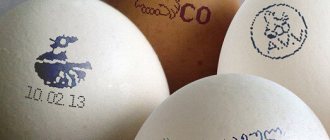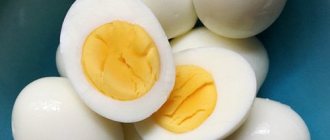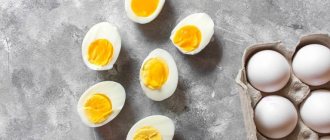Knowing the calorie content of foods is important for anyone losing weight. All diets, to one degree or another, encourage us to control the energy value of food. Since eggs are part of the standard diet of all Russians, the question of how many calories are in an egg interests many. It should be noted that nutritionists have an ambiguous attitude towards this product. Some people recommend eggs for weight loss. On their basis, for example, the nutrition system of endocrinologist Osama Hamdiy was created. Other doctors advise strictly limiting the amount of eggs in your diet. There are regularly recommendations to reduce their consumption to two pieces per week. In this article we will try not only to answer how many calories are in an egg and egg dishes, but also to discuss the advisability of including these products in the menu when fighting excess weight.
How many calories are in different types of eggs?
Most often we use chicken eggs (selected, ordinary or small) and quail eggs for food. How many calories are in an egg depends on its type. Let's look at specific examples. A selected chicken egg weighs about 60 grams. Its calorie content is 94-100 kilocalories. An ordinary chicken egg weighs 50-60 grams. Its calorie content is approximately 78-85 kilocalories in one piece. Small chicken eggs weigh less than 50 grams. Their calorie content per piece is 63-77 kilocalories. You can find out the type of chicken dietary egg by reading the label on the package. Of course, the true calorie content can only be determined by laboratory research. The data we provide is average and varies depending on the time of year, the breed of bird, its age, and the composition of feed at the poultry farm. 100 grams of any chicken egg contains approximately 157-160 kilocalories. There are even more calories in 100 grams of quail eggs - about 168-170. But the eggs of this variety are much smaller. Their weight is about 9-12 grams. How many calories are in the egg of this type of bird? No more than 20 kilocalories in one piece. Other types of eggs are used less frequently in food. A duck or goose egg contains 185 kilocalories per 100 grams, a turkey egg - 165 kilocalories, an ostrich egg - 118 kilocalories. How many calories are in an egg depends primarily on its weight.
Use in cooking
Egg whites are the basis for making the airy meringue dessert. Meringue is deposited both in the form of a cake and used as a layer for cakes. To do this, the protein mass is applied to the pie and baked until a crispy crust forms. The main condition is not to burn the baked goods. The meringue is prepared for at least 1 hour at a temperature of 70 degrees.
Protein cream is widely used in the confectionery industry for decorating cakes and filling baskets, eclairs, and tubes. To diversify the taste and color, flavors and dyes are added to its composition.
Fresh proteins are placed in raw minced meat as a binding agent so that finished products (cutlets, meatballs) do not fall apart. Boiled eggs are added to appetizers, salads, and soups.
Folk recipes
Chicken egg white is used for medical purposes to stop severe nosebleeds, relieve pain from burns, restore a lost voice, and eliminate a sore throat.
- In case of poisoning with mercury and copper salts. To delay the absorption of toxic substances, it is recommended to eat raw egg whites.
- For cuts. The film under the shell can be used as a plaster.
- For headaches. Migraines that occur due to nervousness are recommended to be treated with a cocktail made from raw eggs and hot milk.
- During a neurological attack. It is useful to apply boiled protein to a place with intense pain. It is believed that as the egg cools, the attack weakens.
- For sprains, dislocations. The injured area is lubricated with balm, the recipe of which is borrowed from Tibetan medicine. To prepare it, 10 ml of alcohol is mixed with the white of one egg and flour until a mushy mixture is obtained. The balm is left for at least 2 hours. The compress is bandaged tightly.
- For burns. The burned area is smeared with a white-yolk mixture of a raw egg.
- For sore throat. Raw protein from two chicken eggs is mixed with 30 g of butter, 10 g of flour and 10 ml of natural honey. The resulting mixture is taken 15 g 2-3 times a day.
- For uterine bleeding. Lemon juice (10 ml) is mixed with fresh proteins (6 pcs.), The resulting cocktail is drunk on an empty stomach, provided there are no digestive problems.
Calorie content of egg whites and yolks
An egg can clearly be divided into two parts: the white and the yolk. Their composition differs radically in the content of proteins and fats, as well as calories and microelements. Those who use eggs for weight loss need to know these differences. The yolk is rich in complete animal proteins, fat and cholesterol. It contains about 11.5% fat. Cholesterol in one yolk is 210 mg. Of course, those who struggle with atherosclerosis are forced to almost completely abandon egg yolk. But if you do not have significant problems with blood vessels, then you should not completely abandon this product. The yolk contains a lot of useful substances: omega-3 complex, calcium, folic acid, vitamin D. The calorie content of each chicken egg yolk is approximately 55-65 kilocalories. Protein has completely different nutritional properties. It consists of carbohydrates and proteins (albumin). Protein contains virtually no fat or cholesterol, which means it will not be harmful even with the strictest diet. In terms of energy value, this product can be classified as low-calorie. The calorie content of egg white is only 15-20 kilocalories. If we talk about 100 grams of product, then the calorie content for the yolk is 352 kilocalories, and for the white it is only 45 kilocalories.
Structure and features
This product has great biological value due to the content of chicken eggs that improve the functioning of the body and strengthen the immune system. Consumption of 1-2 pieces per day to cover the body's need for useful elements. The yellowness of the yolk is explained by the presence of carotene, xanthophyll and carotenoid in the composition. It is also worth noting that there are differences between the eggs of chickens and waterfowl. have 15% and 14% more fat and protein .
Let's look at each of the elements:
- Protein - a substance that is formed from 4 layers having different densities:
- outer layer - 23%;
dense protein - 58%;
- internal liquid protein - 17%;
- hailstone protein (adjacent directly to the yellow membrane) - 2%.
- carbohydrates - 0,8%;
- water - 85%;
- fats - 0,3%;
- proteins - 11%.
- glucose;
- amino acids;
- vitamins and enzymes.
- ovalbumin (more than half);
- ovoglobulins;
- lysozymes;
- ovomucoids;
- ovomucines;
- ovotransferrins.
- Yolk - an equally important element, which is an opaque and thick mass located inside a special shell. The task of the latter is to protect the yolk and give it a certain shape. The overall density is at the level of 1.028-1.029. The color can vary from light yellow to dark orange. The yolk consists of the following layers:
- light yolk;
yellow yolk;
- yolk central part (core);
- embryo
- cholesterol - 140 mg ;
- proteins - 2,7%;
- carbohydrates - 0,6%;
- fats - 4,5%.
- retinol;
- vitamins D and B;
- tocopherol;
- lecithin;
- choline;
- polyunsaturated fatty acids (linoleic and linolenic acids - 6% and 16% , respectively);
- monosaturated fatty acids (oleic and palmitoleic acids - 47% and 5% , respectively);
- saturated fatty acids - palmitic ( 23% ), myristic ( 1% ) and stearic ( 4% ).
- Shell. Many people underestimate the importance of another element of a chicken egg - the outer hard shell. It contains the following elements:
- calcium phosphate;
magnesium;
- copper;
- iron;
- collagen.
- white - in egg-bearing breeds;
- yellowish or brown - for meat.
- Wash the shell in soapy water after removing it from the raw egg.
- Let the product dry, then peel off the film from the inside and grind the shells using a coffee grinder.
The yolk is held in the central part using special ligaments (hailstones). The quality of the product is often judged by the volume of the dense part. In the case of long-term storage, the structure of the substance liquefies, and the chemical composition of the eggs gradually changes.
Protein is a building material that is used by the body to build new tissues. With its help, muscles are formed, the immune system is strengthened, and metabolic processes are improved.
Compound:
The protein also contains:
Calorie content - 17-20 kcal .
The chemical composition of protein deserves special attention:
Changes in the composition and calorie content of the yolk directly depend on the protein mixture around it. If the protein liquefies, then the water that is bound to it comes out and penetrates through the shell, and then through the outer protection of the yolk. As a result, the size of the latter increases, and the yolk itself becomes ellipsoidal.
Nutritionists claim that the central part is the main one. This is explained by its high calorie content - 50-60 kcal .
Chicken yolk composition:
Many people are concerned about high cholesterol levels. In fact, the existing harm is compensated by the action of lecithin. In addition, the product contains a large amount of healthy fats, without which the body is not able to develop normally.
Let's look at what is contained in the yolk:
The thickness of the shell varies depending on the breed of bird. On average, this figure ranges from 0.3 to 0.6 mm . The shell contains more than 7.5 thousand pores. At the same time, there are fewer of them on the “blunt” side, which explains its lower rigidity. Pores in the shell allow moisture and carbon dioxide to escape from the egg. In addition, it protects against the effects of negative natural factors.
The shell varies in color:
The quality of the shell and egg as a whole can be recognized by the following criteria - smoothness, cleanliness and density.
On the surface of the shell there is an additional (suprashell) shell. It is thanks to this protection that the evaporation of moisture, which is contained in the yolk of a chicken egg, as well as in the white of the product, is prevented.
The egg also has an undershell shell that protects the inside from the penetration of bacteria, UV rays and water vapor. This defense is often referred to in the literature as protein defense.
If a chicken egg has just been laid, then there is still no air space between several shells. After cooling, the volume of the egg decreases, and the protein part inside pulls the shell layer towards itself. The outer shell remains in place, creating space between the two shells. The longer the product is stored, the greater this distance becomes. By the size of the space you can judge how fresh the product is.
Eggshells are one of the best sources of calcium. Already one egg contains 1.8-2.0 grams of a useful element. Other substances are also present in the composition - iron, phosphorus, copper and manganese.
People often throw away the shells. In practice, its technique is very useful. The calcium in the shell is almost completely absorbed by the body, improving the condition of nails, teeth and fingernails. To “cook” follow these steps:
Please note that it is prohibited to take shells without a doctor’s recommendation due to the presence of some contraindications (for example, if you have cancer).
Calorie content of soft-boiled and hard-boiled eggs
As a cooking method, the easiest way to cook eggs is to boil them. The boiling time determines whether the egg is soft-boiled or hard-boiled. The calorie content of the product is almost the same in both cases. The calorie content of a hard-boiled egg is 160 kilocalories per 100 grams. The calorie content of a soft-boiled egg is almost the same - 157-159 kilocalories per 100 grams of product. The longer the egg has been cooked, the longer it will take to digest it in the gastrointestinal tract. In addition, hard-cooked eggs can last longer. In any case, the digestibility of nutrients remains high.
The benefits and harms of raw eggs
Like any other product, raw eggs can be both beneficial and harmful to the body.
Photo source: shutterstock.com
Useful properties of raw eggs
The main positive property is the antioxidant effect provided by lutein, which is part of the chemical composition of the product. Lutein is also very beneficial for visual function. Thanks to this element, the risk of developing cataracts is prevented.
The positive properties of a raw egg lie in the fact that its composition is filled with various vitamins, valuable acids and microelements, which include:
- olin;
- calcium;
- phosphorus;
- folic acid.
Such substances provide strengthening of nails and skin. They have a beneficial effect on the condition of bones and hair. Due to them, human immunity is strengthened. The nervous system becomes more resistant and stronger to the effects of external negative factors.
Raw eggs are very beneficial for athletes. If you eat them after a workout, your productivity increases and your muscle mass begins to grow.
Harm from raw eggs
But not everyone thinks raw eggs are healthy. However, the danger comes only from a product contaminated with salmonellosis. After heat treatment, this bacterium is completely destroyed.
Photo source: shutterstock.com
If you decide to introduce a raw product into your diet, you should evaluate several points when purchasing it to avoid poisoning. You need to choose eggs that are whole and smooth, without cracks. It is best to buy fresh country eggs. They should be stored strictly in the refrigerator at home. Before eating, it is recommended to wash eggs thoroughly with soap so that bacteria contained on the shell cannot enter the food.
You should also be careful when introducing raw eggs into your child’s menu. Despite the fact that such food is really healthy, it often provokes severe allergic reactions.
ABC RECOMMENDS
How many calories are in 1 boiled egg?
Calories in fried egg
Fried eggs are much more nutritious than raw or boiled ones. This is due to the fact that this method of cooking uses fat (vegetable oil or butter). All oils are extremely high-calorie foods. Vegetable oil (including olive oil) is considered the champion in calorie content. In 100 grams it contains about 900 kilocalories. This is so much that it significantly exceeds the energy value of mayonnaise, lard, chocolate and sugar. Fried eggs in 100 grams contain 240 kilocalories. This is a third more than in raw or boiled eggs. An omelet is prepared from eggs with the addition of milk, cream, flour, and cheese. Its calorie content can be 200-350 kilocalories. The calories in a fried egg are most often unnecessary for any nutrition system.
Calorie content of raw eggs
The energy value and calorie content of eggs depends not only on their size, but also on the variety. You can find C0 eggs on sale. The calorie content of this product is 143 kcal. But the C1 variety is more common. Its calorie content is higher than that of C0, reaching 157 kcal.
How many calories does the yolk have? For 1 piece accounts for 354 kcal, while there is not a single gram of carbohydrates in it. Protein is somewhat “lighter”. It contains 158 kcal, and per 100 grams there is not a single gram of fat. The indicator for a C2 egg, whose weight without shell is 45 grams, is 156.2 kcal.
The total calorie content of an average egg is 72 kcal. At the same time, 43 kcal comes from the fat composition.
Egg powder
The calorie content of egg powder is extremely high. This product contains about 542 kilocalories per 100 grams. Of course, we never eat this product in large quantities and in its pure form. Otherwise, soon we would all face an acute problem of obesity. The calorie content of dry egg whites and yolks also varies greatly. 100 grams of dry protein contains approximately 336 kilocalories. This is a lot, but still significantly less than in dry yolks. Their calorie content is almost 625 kilocalories per 100 grams.
Results
Knowing the calorie content of a raw, boiled or fried chicken egg will not be superfluous. This will help shape your diet and accurately determine the appropriate number of eggs per day. And most importantly, you should not be afraid of cholesterol, which is supposedly contained in large quantities. If you do not abuse the product, it only brings benefits:
- stimulates the immune system;
- helps with weight loss (when consumed boiled);
- strengthens bones and teeth;
- improves memory and activates brain activity;
- promotes cell renewal and rejuvenation of the body.
Daily serving: 1-2 eggs. This is enough for the body to receive the lion's share of the key elements.
Eggs for weight loss
Some diets use eggs for weight loss. First of all, we are talking about low-carb diets. Such diets are based on modern ideas about metabolism. By eliminating carbohydrates, we launch fat breakdown processes. As a result, ketone bodies appear in the blood, which help suppress appetite. Eggs can also be used in low-calorie diets. The calorie content of hard-boiled and soft-boiled eggs allows us to consider these products dietary. Their energy value per serving is low. And the feeling of fullness comes for a long time. Eggs are a source of valuable vitamins and microelements. Moreover, these substances are absorbed from eggs very well. A chicken egg per 100 grams contains: phosphorus - 192 milligrams, potassium - 140 milligrams, sodium - 134 milligrams, calcium - 55 milligrams, magnesium - 12 milligrams, iron - 2.5 milligrams, copper - 83 micrograms, cobalt - 10 micrograms. All these substances are especially needed to maintain health for those who are constantly struggling with excess weight through various unbalanced diets. However, overuse of eggs can lead to undesirable consequences. This is especially true for those whose cholesterol levels, according to blood biochemistry, exceed normal values. Therefore, eggs for weight loss should be used only with good blood biochemistry tests.
Composition and nutritional value of eggs
The composition of a chicken egg is quite rich. 1 piece contains:
- 0.88 mg iron;
- 0.53 mg vitamin E;
- 6 mg magnesium;
- 71 mg sodium;
- 80 mcg vitamin A;
- 0.65 mg zinc;
- 1 mcg vitamin D;
- 69 mg potassium;
- 0.09 mg vitamin B6;
- 28 mcg calcium;
- 0.45 mcg vitamin B12.
Now let's take a closer look at the BJU of the product. The total carbohydrate content is 0.36 g, of which 0.19 g is sugar. There is no dietary fiber in the composition.
Total protein is 6.28g and fat is 4.76g. At the same time, 186 mg is cholesterol, 1.83 g is monounsaturated fat, 1.57 g is saturated and 0.96 g is polyunsaturated.
Eating eggs on a diet
Every person who wants to gain weight and adheres to a diet is invariably interested in the question of whether this product is compatible with the process of losing weight. In this matter, you should listen to the advice of nutritionists. Many experts recommend eating 2 to 3 eggs per week. On low-carb diets, this amount can be increased.
Including eggs in your diet can help you lose weight and support your immune system. Hard-boiled, they are found in most popular diet programs. Among them are Protasova, Atkins, by blood group, Kremlin and, of course, protein.
Chicken salad with egg pancakes
Ingredients:
- 500 grams of chicken fillet;
- 7 chicken eggs;
- onion;
- can of canned corn;
- 7 tbsp. l. sour cream;
- Art. l. rast. oils;
- 150 ml water;
- 1.5 tbsp. l. Sahara;
- salt.
Let's prepare our salad:
- We wash the fillet and set it to cook over medium heat. After the water boils, cook the meat for another half hour. Don't forget to salt the water.
- Peel the onion and cut into half rings.
- Prepare the pancakes: break the eggs into a bowl and add a little salt. Shake with a fork. Fry the pancakes in a frying pan in vegetable oil on both sides for a minute.
- We should have about seven pancakes. Stack them and cut them into thin strips.
- We cut the boiled chicken fillet into strips.
- Fry the onion for 3-4 minutes.
- Now we assemble the salad: put the fillet, onion, pancakes and corn together and mix. Season with sour cream. If the salad seems unsalted, add a little salt.
The salad will taste better if it is left to cool in the refrigerator for an hour. Bon appetit!
The effect of protein on muscle mass
Why do all bodybuilders eat eggs? The fact is that they contain a lot of protein, which is necessary for gaining muscle mass. Without regular physical activity and protein intake, muscles will not grow.
In addition, during intense strength training, protein fibers are damaged, resulting in the need to restore them, and the need for amino acids increases.
Should I drink powdered eggs? This product contains 3 times more protein than boiled eggs. Therefore, it is necessary to use the supplement correctly.
Egg protein increases the level of hemoglobin and testosterone, supplies a large amount of leucine (BCAA amino acid), effectively satisfies the feeling of hunger, increases the athlete's strength capabilities, restores damaged fibers after training, and is completely absorbed.
Protein is taken based on the calculation of 2 g of protein per 1 kg of weight. Thus, the daily dose of egg powder is 3-4 scoops. During a training day, the product is consumed four times: in the morning on an empty stomach, 30 minutes before training, immediately after it and immediately before bed.
After gaining weight, “drying” should occur on the eggs. First, the muscles increase mass, then get rid of excess fluid, making the body look lean.
Intensive training while “drying” muscles helps to acquire beautiful relief.
Studies have found that eating 3 eggs in the morning on an empty stomach doubles the growth rate of muscle mass. It is not recommended to give up yolks, as they improve protein absorption.
A chicken egg is one of the healthiest foods for a bodybuilder’s body, containing all the essential amino acids for nutrition and muscle recovery after sports. In order to support the body, it is recommended to consume exclusively thermally cooked protein. This way it is absorbed faster and does not pose a threat of salmonellosis infection.
To gain muscle mass, it is recommended to eat 6-8 eggs per day. At the same time, protein should account for 25-30% of the daily diet. The more intense the load, the higher the body's need for proteins. In addition to eggs, the athlete’s menu should include seafood, legumes, cottage cheese, milk, and low-fat meat.
Remember, gaining muscle mass is only possible through a combination of two key factors: a balanced diet and regular physical activity.
Protein alone will not increase your muscle mass. To grow, muscles need “fuel”, which is supplied to the body by carbohydrates. Glucose deficiency triggers the processes of using up glycogen reserves and destroying your own protein. As a result, a person will practice without getting results.
For muscle development, 55-65% of the daily diet should come from complex carbohydrates: brown rice, bananas, pears, hard grain flour products, porridge. You should not give up fats, they ensure the normal functioning of metabolism. Lipids account for 10-15%. Preference should be given to fats of vegetable origin (olive, corn oil).
How to choose and store eggs: Is it true that cinnamon eggs are healthier?
When buying eggs, try to choose the freshest possible. There is no difference between the nutritional properties of white and brown eggs. However, some types of eggs have great nutritional value.
For example, some stores sell Omega-3 eggs. They are carried by chickens that are fed flax seeds to boost their omega-3 levels. Also, birds that feed on greens, larvae and other natural products produce eggs with a high content of this element. The packaging of such a product may contain the label “domestic eggs”.
At home, eggs should be stored in the refrigerator at a temperature of about 4°C or less. Typically, eggs can be stored for about 3 weeks from the date of purchase.
They can also be frozen for up to 1 year. To do this, they need to be peeled, stirred and placed in an airtight container.
Egg recipes
As we have already said, we will never know the exact number of existing recipes with the addition of eggs, because almost every day new interesting dishes are invented.
Eggs are a universal product that absolutely all housewives love. It can be fried, boiled, baked. This is one of the required ingredients in many salads, as well as in baked goods: pancakes, pancakes, cheesecakes, cakes, pies, muffins, pastries. Every housewife and every second man knows how to boil and fry eggs.
Consider a recipe for a delicious salad with egg pancakes.











